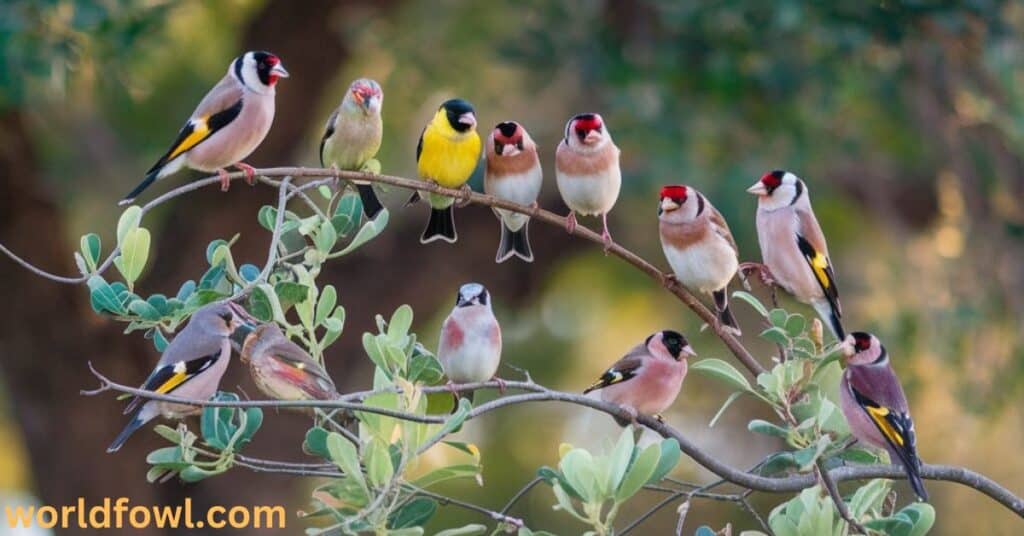Texas, with its vast and varied landscapes, plays host to a dazzling array of birdlife. Among these avian wonders, finches hold a special place in the hearts of bird enthusiasts and casual observers alike. From the vibrant American Goldfinch to the unique Red Crossbill, Texas finches offer a captivating glimpse into the diversity of nature. This comprehensive guide will take you on a journey through the world of Texas finches, exploring their characteristics, habitats, and the joy they bring to birders across the state.
The Finch Family: A Texas Perspective
Finches, belonging to the family Fringillidae, are small to medium-sized songbirds known for their conical beaks, melodious songs, and often colorful plumage. These adaptable birds have carved out niches in various ecosystems across North America, with Texas serving as a critical habitat for several species.
What sets finches apart? Their specialized beaks, evolved for cracking seeds, are a hallmark feature. But it’s not just about looks – finches play crucial roles in seed dispersal and insect control, making them integral to Texas ecosystems.
The Lone Star State’s diverse geography, from the piney woods of the east to the arid deserts of the west, creates a mosaic of habitats that support a rich finch population. This diversity makes Texas a finch hotspot, attracting both year-round residents and seasonal visitors.
Evolutionary History of Finches in North America
The story of finches in North America is a tale of adaptation and diversification. Fossil evidence suggests that finch-like birds have been present on the continent for millions of years. However, many of the species we see today in Texas are the result of more recent evolutionary processes.
During the Pleistocene epoch, glacial cycles caused dramatic shifts in habitats across North America. These changes created opportunities for finch populations to become isolated and adapt to new environments. As a result, we see a variety of specialized finch species today, each suited to particular ecological niches.
For instance, the Cassin’s Finch, found in the high elevations of West Texas, is adapted to life in coniferous forests. Its stronger bill allows it to crack open tough pine cones, a skill that gives it an edge in its mountain home.
you may also like: Herons In Michigan – The Complete Guide To 8 Michigan
Texas: A Finch Hotspot
Texas’s position as a finch hotspot is no accident. The state’s geographical location and diverse habitats make it an ideal home for a variety of finch species. Here’s why:
- Geographical Diversity: From the Gulf Coast to the High Plains, Texas offers a range of ecosystems that support different finch species.
- Migratory Crossroads: Texas lies along major bird migration routes, making it a crucial stopover for many finch species during their annual journeys.
- Climate Variability: The state’s varied climate, from humid subtropical in the east to arid in the west, provides suitable conditions for both northern and southern finch species.
- Abundant Food Sources: Texas’s diverse plant life, including numerous seed-producing species, provides ample food for finches year-round.
Common Finch Species in Texas
American Goldfinch
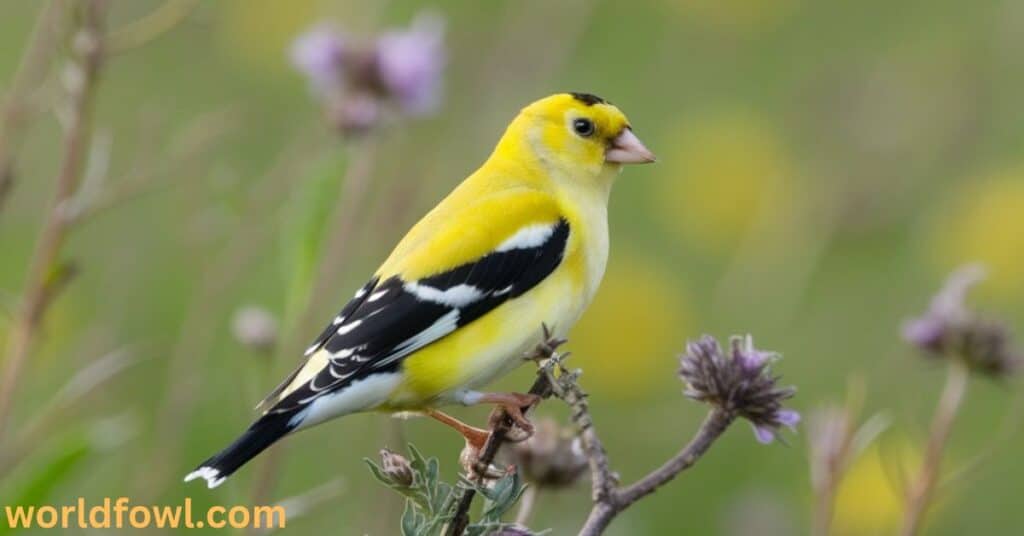
The American Goldfinch (Spinus tristis) is a crowd-pleaser, beloved for its bright yellow summer plumage. These cheerful birds undergo a dramatic transformation throughout the year, shifting from vibrant gold to a more subdued olive-brown in winter.
Identification Tips:
- Males in breeding plumage: Bright yellow body with black cap and wings
- Females and winter birds: Olive-brown with yellowish undertones
- Both sexes: Distinctive white wing bars and tail edges
Fun Fact: American Goldfinches are strict vegetarians, one of the few birds that feed their young an all-seed diet.
These finches prefer open country with scattered trees and shrubs. In Texas, you’ll often spot them in fields, gardens, and along roadsides, especially where thistle and sunflowers grow abundantly.
Seasonal Behavior in Texas: American Goldfinches exhibit interesting seasonal patterns in Texas. While some individuals are year-round residents, particularly in the northern parts of the state, many are winter visitors from more northern breeding grounds.
- Spring: Watch for males molting into their bright breeding plumage. This usually occurs in late March to early April in Texas.
- Summer: Although less common during this season, some may breed in North Texas. Look for their cup-shaped nests in shrubs or small trees.
- Fall: Large flocks begin to appear as northern birds migrate south. This is a great time to observe their social behavior.
- Winter: Peak season for American Goldfinches in Texas. They form large, chattering flocks that move nomadically in search of food sources.
House Finch
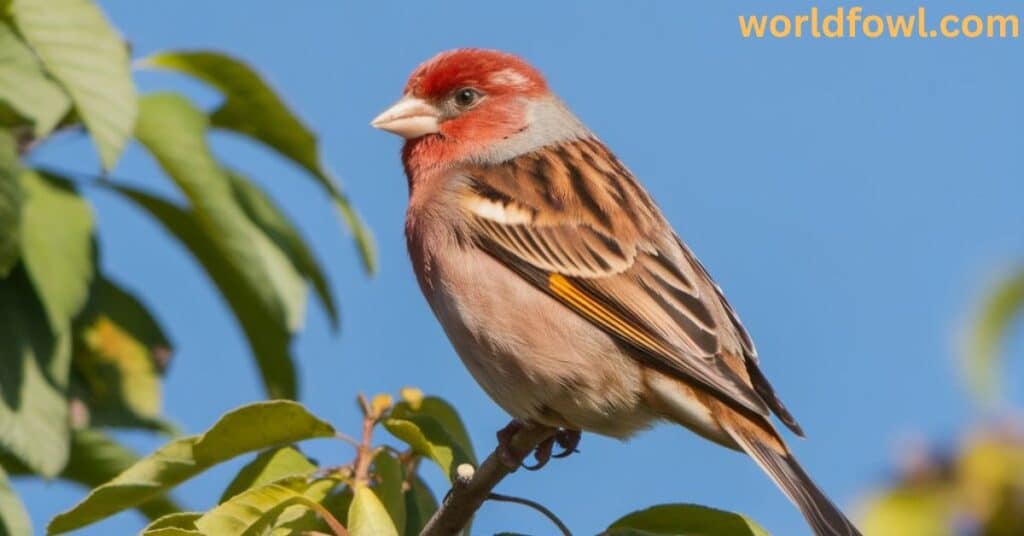
The House Finch (Haemorhous mexicanus) is perhaps the most common finch species in Texas urban areas. Originally native to the western United States, it has successfully colonized the entire country.
Key Characteristics:
- Males: Rosy red head, breast, and rump
- Females: Brown streaked bodies without red coloration
- Both sexes: Stout beaks and notched tails
House Finches have adapted remarkably well to human environments. You’ll find them nesting in hanging planters, on building ledges, and even in traffic lights across Texas cities.
Case Study: The Texas House Finch Invasion In the 1940s, pet store owners in New York illegally released House Finches to avoid fines. This eastern population spread rapidly, eventually connecting with the native western population in Texas. Today, House Finches are ubiquitous across the state, showcasing their incredible adaptability.
House Finch Diet and Feeding Behavior: House Finches are primarily seed-eaters, but their diet is more varied than many people realize:
- Seeds: They favor sunflower seeds, especially at feeders. In the wild, they consume a variety of small seeds from grasses and weeds.
- Fruits: Berries and small fruits make up a significant portion of their diet, especially in late summer and fall.
- Buds and Nectar: In spring, they often feed on tree buds and flower nectar, sometimes damaging ornamental plants.
- Insects: While not a major part of their diet, House Finches will occasionally eat small insects, especially when feeding young.
Interestingly, the red coloration in male House Finches comes from carotenoid pigments in their food. Birds with access to a diet rich in these pigments tend to be brighter red, which can make them more attractive to potential mates.
you can also read : Parrots in Florida – The Complete Guide To Wild Parakeets In Florida
Lesser Goldfinch
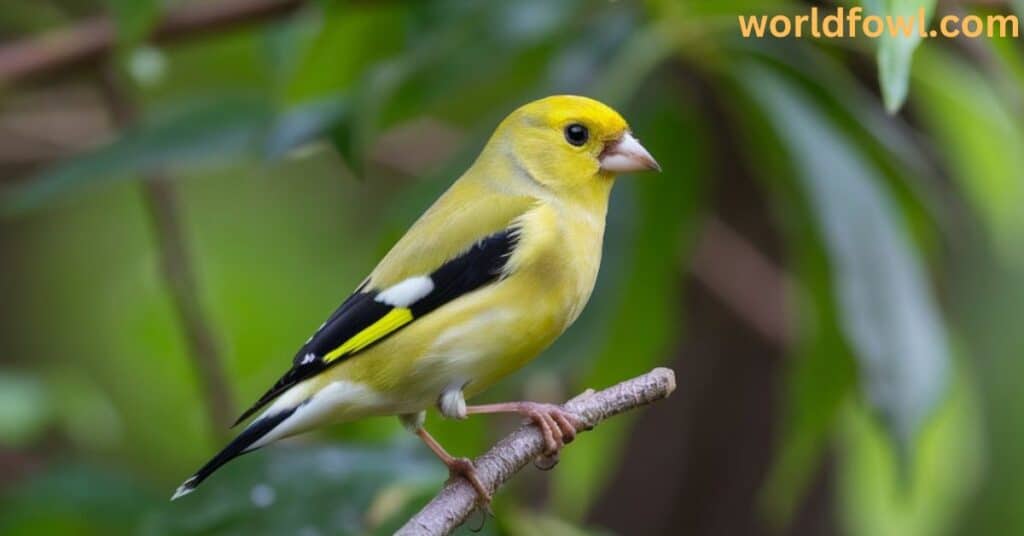
The Lesser Goldfinch (Spinus psaltria) is a tiny finch with a big personality. Often confused with its American cousin, this species is a year-round resident in much of Texas.
Distinguishing Features:
- Males: Black cap, greenish back (Texas birds often have black backs)
- Females: Olive-green upperparts, yellowish underparts
- Both sexes: Smaller size compared to American Goldfinch
Lesser Goldfinches thrive in semi-open habitats, including woodland edges, gardens, and riparian areas. They’re particularly fond of sunflower seeds and can often be spotted hanging acrobatically from seedheads.
Vocalizations and Behavior: Lesser Goldfinches are known for their complex and variable songs. Males have a canary-like warble that often incorporates mimicry of other bird species. Their calls include a sharp “ti-ti-ti” and a plaintive “p-tee-ee.”
In terms of behavior, Lesser Goldfinches are highly social birds. They often form small flocks, even during the breeding season. These flocks can be seen feeding together on weed seeds or visiting bird feeders. Their acrobatic feeding style, often hanging upside down to reach seeds, is a delight to watch.
Pine Siskin
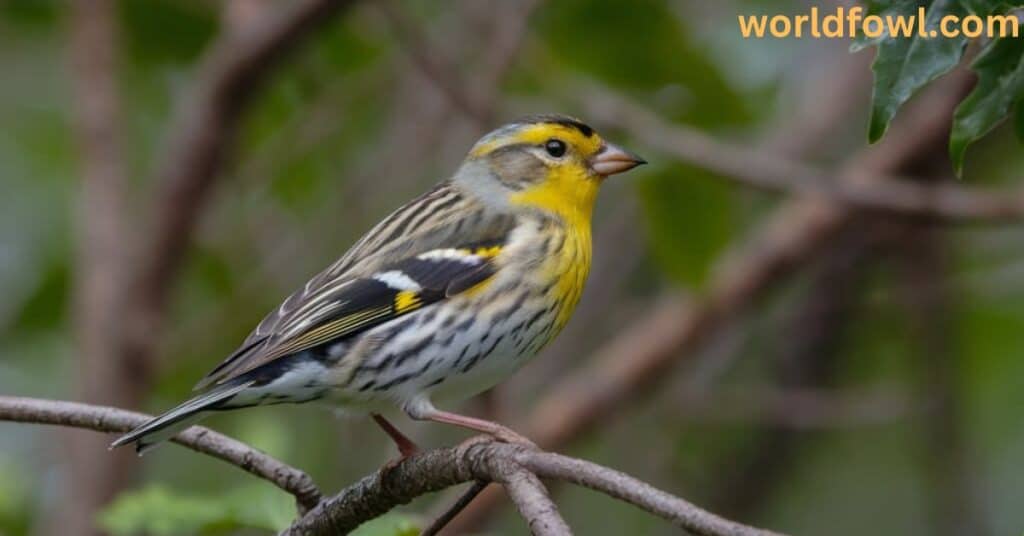
The Pine Siskin (Spinus pinus) is an irruptive species in Texas, meaning its presence can vary dramatically from year to year depending on food availability in its northern breeding grounds.
Identification Challenges:
- Overall brown-streaked appearance
- Yellow edges on wings and tail (can be subtle)
- Sharp, pointed beak
Pine Siskins are social birds, often forming large flocks in winter. During irruption years, Texas birders might see hundreds at their feeders, especially those offering nyjer seeds.
Irruptive Behavior Explained: The irruptive nature of Pine Siskins is a fascinating aspect of their biology. Here’s a deeper look at this phenomenon:
- Food-Driven Movement: Pine Siskins primarily feed on conifer seeds. When seed production is low in their northern breeding grounds, they move south in large numbers.
- Unpredictable Patterns: Unlike regular migrants, Pine Siskins don’t follow a set annual schedule. Some years they may be abundant in Texas, while in others they might be completely absent.
- Mixed Flocks: During irruptions, Pine Siskins often travel with other finch species, particularly American Goldfinches. This can lead to exciting mixed flocks at feeders.
- Timing: Irruptions typically occur in fall and winter, with birds arriving in Texas anytime from October to December.
- Environmental Indicators: The presence of large numbers of Pine Siskins can be an indicator of environmental conditions in boreal forests thousands of miles away.
For Texas birders, staying alert to reports of Pine Siskin irruptions can lead to exciting birding opportunities. eBird alerts and local birding groups are great resources for tracking these events.
Less Common but Notable Texas Finches
Purple Finch
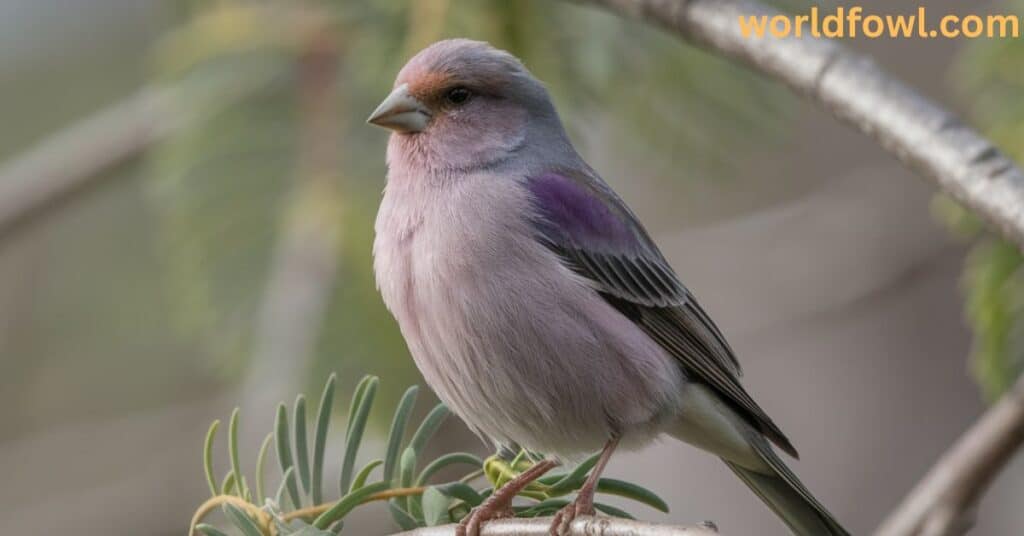
Despite its name, the Purple Finch (Haemorhous purpureus) isn’t truly purple. This species is less common in Texas, primarily appearing as a winter visitor in the eastern part of the state.
Comparison with House Finch:
| Feature | Purple Finch | House Finch |
| Color | Raspberry red | Bright red |
| Breast | Solid color | Streaked |
| Head | Fully colored | Red limited to forehead and throat |
Purple Finches prefer coniferous and mixed forests. In Texas, they’re most likely to be spotted in the Piney Woods region during colder months.
Migration Patterns in Texas: Understanding the migration patterns of Purple Finches in Texas can help birders know when and where to look for these beautiful birds:
- Arrival: Purple Finches typically begin arriving in Texas in late October or early November.
- Peak Presence: The highest numbers are usually seen from December through February.
- Departure: Most Purple Finches leave Texas by early April, heading back to their northern breeding grounds.
- Habitat Preference: During their stay in Texas, Purple Finches favor areas with abundant seed sources. Look for them in mature forests, especially those with a mix of deciduous and coniferous trees.
- Yearly Variation: Like many winter finches, the number of Purple Finches visiting Texas can vary greatly from year to year. This variation is often linked to seed crop production in their northern breeding range.
- Observation Opportunities: Bird feeders can be excellent places to spot Purple Finches, especially those offering sunflower seeds. They may also be found in parks and nature preserves with suitable habitat.
Remember, distinguishing Purple Finches from the more common House Finches can be challenging, especially for novice birders. Taking the time to carefully observe field marks and compare the birds to field guide descriptions can help ensure accurate identification.
you might like : Why Do Hawks Screech? The Surprising Truth
Cassin’s Finch
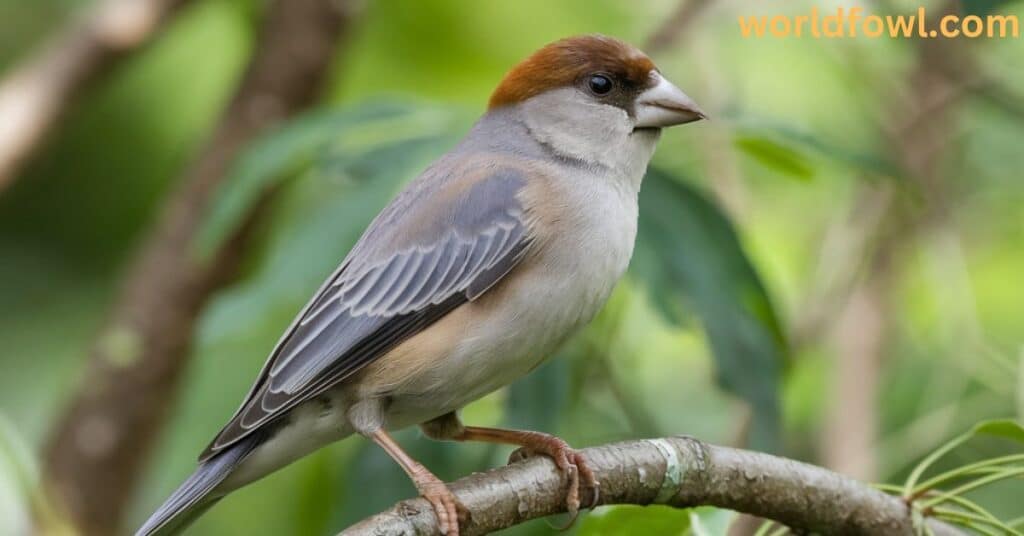
The Cassin’s Finch (Haemorhous cassinii) is a western specialty, reaching the eastern limit of its range in Texas. It’s primarily found in the Davis Mountains and other high-elevation areas of West Texas.
Habitat Requirements:
- Coniferous forests
- High-elevation woodlands
- Mountain meadows
Cassin’s Finches are adaptable feeders, consuming a variety of seeds, buds, and insects. Their presence in Texas offers birders a chance to observe a species not commonly seen in most of the state.
Cassin’s Finch in the Davis Mountains: The Davis Mountains provide a unique ecosystem that supports Cassin’s Finches in Texas. Here’s why this area is so important for the species:
- Elevation: The Davis Mountains reach elevations over 8,000 feet, providing the cool, high-altitude environment that Cassin’s Finches prefer.
- Forest Composition: The mountains host a mix of pine-oak woodlands and coniferous forests, offering ideal habitat for these finches.
- Isolation: The Davis Mountains are an isolated “sky island,” providing a haven for montane species like Cassin’s Finch in an otherwise arid landscape.
- Seasonal Movements: While some Cassin’s Finches may be year-round residents in the Davis Mountains, others move to lower elevations in winter.
- Birding Hotspots: Key areas to look for Cassin’s Finches include Davis Mountains State Park, Mount Locke, and the Nature Conservancy’s Davis Mountains Preserve.
- Conservation Importance: The presence of Cassin’s Finches in the Davis Mountains underscores the ecological significance of this area and the need for its continued protection.
For Texas birders, a trip to the Davis Mountains offers not only a chance to see Cassin’s Finches but also to experience a unique ecosystem home to many other montane bird species.
you can read: Why Do Crows Chase Hawks? Do Crows Hate Hawks?
Red Crossbill
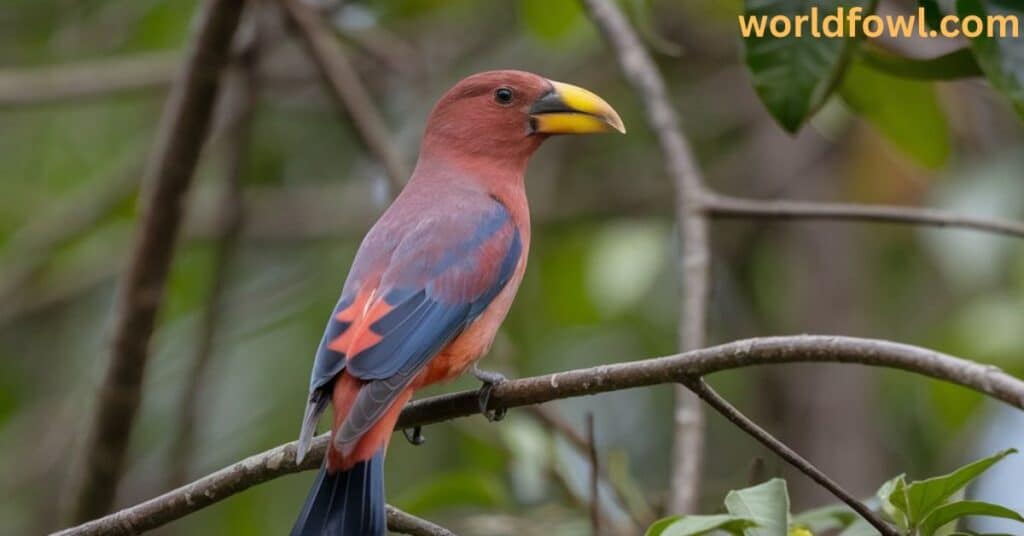
The Red Crossbill (Loxia curvirostra) stands out among finches due to its uniquely crossed bill tips, an adaptation for extracting seeds from conifer cones.
Unique Beak Adaptation:
- Upper and lower mandibles cross at the tip
- Allows for efficient seed extraction from pine cones
- Different populations have slightly different bill shapes, adapted to local cone types
Red Crossbills are nomadic, following cone crops. In Texas, they’re most likely to be found in the Guadalupe Mountains or other areas with significant conifer forests.
Subspecies Variation in Texas: Red Crossbills are known for their complex taxonomy, with several recognized “types” or subspecies. This variation is particularly interesting in the context of Texas:
- Type 2 (Ponderosa Pine Crossbill): This is the most likely type to be encountered in Texas, particularly in the Guadalupe Mountains. They’re adapted to feeding on Ponderosa Pine cones.
- Type 3 (Western Hemlock Crossbill): Occasionally reported in Texas, these birds are usually associated with Douglas-fir and hemlock forests further west.
- Vocal Differences: Each crossbill type has distinct flight calls. Learning these calls can help birders identify which type they’re observing.
- Irruptive Behavior: Like other crossbills, the occurrence of these types in Texas can be irregular, depending on cone crop failures in their core ranges.
- Research Opportunities: The presence of different crossbill types in Texas provides opportunities for citizen scientists to contribute to our understanding of these complex birds.
Birders interested in Red Crossbills should familiarize themselves with the different types and their calls. Recording crossbill vocalizations and submitting them to projects like eBird can provide valuable data for researchers studying these fascinating birds.
Seasonal Finch Watching in Texas
Finch activity in Texas varies dramatically with the seasons, offering year-round excitement for bird enthusiasts.
Spring: A Symphony of Songs
As temperatures rise, male finches burst into song to establish territories and attract mates. This is the perfect time to:
- Listen for the varied songs of different finch species
- Observe courtship behaviors, including aerial displays and feeding rituals
- Watch for nest-building activities, often in shrubs or low trees
Spring Finch Watching Highlights:
- American Goldfinch Transformation: Watch as male American Goldfinches molt into their bright yellow breeding plumage.
- House Finch Nesting: Observe House Finches constructing nests in hanging planters, wreaths, or building ledges.
- Lesser Goldfinch Courtship: Look for male Lesser Goldfinches performing undulating flight displays to attract females.
- Pine Siskin Departure: If it was an irruption year, watch for the last Pine Siskins to depart for their northern breeding grounds.
- Purple Finch Migration: Catch a glimpse of the last Purple Finches as they head north, typically leaving Texas by early April.
Summer: Family Time
Summer brings the busy season of raising young. Keep an eye out for:
- Parent birds making frequent trips to and from the nest
- Fledglings begging for food with fluttering wings
- Family groups feeding together in gardens and fields
Summer Finch Behavior:
- House Finch Families: Watch for family groups at feeders, with youngsters begging from parents.
- Lesser Goldfinch Breeding: These year-round residents are in full breeding mode during summer.
- American Goldfinch Late Nesters: Unlike
- American Goldfinch Late Nesters: Unlike many other birds, American Goldfinches are late nesters. They often don’t begin breeding until July, when thistle seeds become abundant.
- Cassin’s Finch in the Mountains: For those venturing to the Davis Mountains, summer is prime time to observe Cassin’s Finches in their breeding habitat.
- Red Crossbill Movements: In years with good cone crops, Red Crossbills might breed in Texas coniferous forests. Look for family groups in places like the Guadalupe Mountains.
Fall: Migration Movements
While some finch species are year-round Texas residents, others undergo migration. Fall is an excellent time to:
- Watch for large flocks of American Goldfinches moving south
- Spot the first arriving winter visitors, like Purple Finches
- Observe changes in plumage as birds molt into winter colors
Fall Finch Watching Highlights:
- American Goldfinch Flocks: Large flocks begin to form as birds prepare for migration. Watch for them feeding on sunflowers and other seed-bearing plants.
- Pine Siskin Irruptions: Keep an eye out for early signs of Pine Siskin irruptions, which typically begin in October if they’re going to occur.
- Purple Finch Arrival: The first Purple Finches usually arrive in East Texas in late October or early November.
- Lesser Goldfinch Gatherings: While not migratory in Texas, Lesser Goldfinches may form larger flocks in fall as young birds disperse.
- House Finch Color Variations: As young House Finches mature, observe the variety of red, orange, and yellow colorations in males.
Winter: Irruptive Species and Feeder Activity
Winter can bring exciting finch activity, especially during irruption years. Look for:
- Increased activity at feeders, particularly on cold or stormy days
- Mixed flocks of finches foraging together
- Rare northern visitors like Pine Grosbeaks or Evening Grosbeaks
Winter Finch Behavior:
- American Goldfinch Winter Plumage: Observe the more subdued olive-brown winter plumage of American Goldfinches.
- Pine Siskin Irruptions: During irruption years, hundreds of Pine Siskins might descend on nyjer seed feeders.
- Purple Finch vs. House Finch: Practice distinguishing between these similar species as Purple Finches reach their peak numbers in Texas.
- Red Crossbill Nomads: In some winters, Red Crossbills might appear in Texas coniferous forests, following good cone crops.
- Lesser Goldfinch Hardiness: Despite their small size, Lesser Goldfinches tough out the Texas winter. Watch for them at feeders on cold days.
Conservation and Challenges
Texas finches face several challenges in our changing world. Understanding these issues is crucial for their conservation.
Habitat Loss and Fragmentation As urban areas expand and natural habitats are converted for agriculture, finches lose critical breeding and foraging grounds. Conservation efforts focus on:
- Preserving large tracts of diverse habitats
- Creating wildlife corridors to connect fragmented area
Climate Change Impacts Shifting climate patterns affect finches in various ways:
- Changes in plant phenology can disrupt food availability
- Altered migration timing may lead to mismatches with resource peaks
Case Study: Climate Change and the American Goldfinch Research has shown that American Goldfinches are nesting about a week earlier than they did a few decades ago, likely in response to warming temperatures. While this might seem like a small change, it can have significant impacts:
- Food Availability: If goldfinches nest earlier, but the plants they rely on for food and nesting material don’t shift their timing to the same degree, it could lead to a mismatch between the birds’ needs and resource availability.
- Competition: Earlier nesting might bring goldfinches into competition with other bird species for resources
This case study highlights the complex ways in which climate change can affect even our most common finch species.
Urban Hazards As adaptable as many finch species are, urban environments pose unique risks:
- Window collisions are a major cause of bird mortality
- Outdoor cats can significantly impact local bird populations
Success Stories Despite these challenges, there are positive developments:
- The comeback of the House Finch in Texas after the 1990s eye disease epidemic
- Increased awareness and participation in citizen science projects like eBird
This event underscores the importance of monitoring bird populations and the value of citizen science in tracking and understanding such phenomena.
you can read : How and Where Do Geese Sleep? The Secrets of Goose Slumber
Attracting Finches to Your Texas Backyard
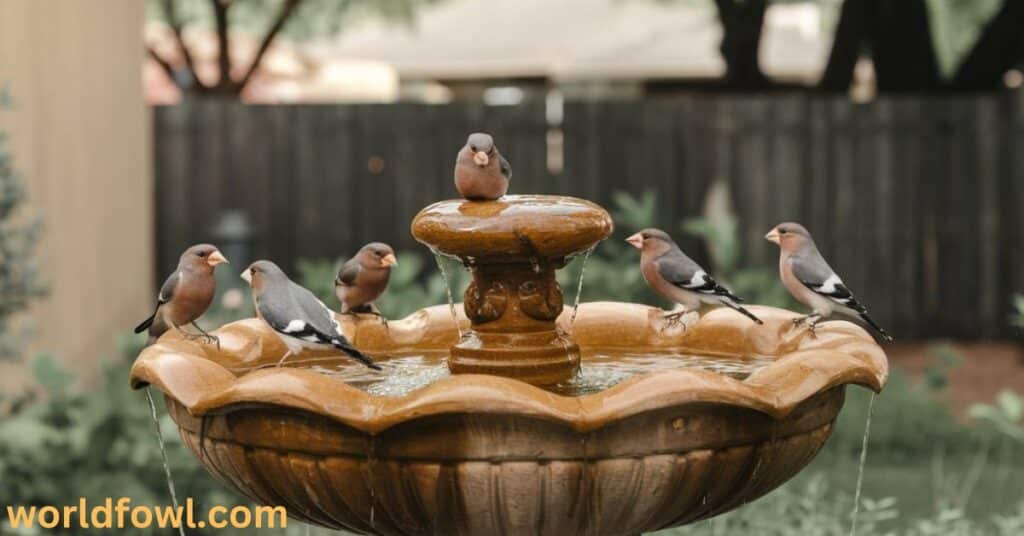
Creating a finch-friendly backyard can bring these charming birds up close. Here are some tips:
- Native Plant Landscaping
- Plant sunflowers, coneflowers, and native thistles
- Include seed-bearing trees like pine and elm
- Preserve natural “weed” patches that produce small seeds
- Feeder Types and Preferred Seeds
- Use tube feeders for nyjer seeds (favorite of goldfinches)
- Offer black oil sunflower seeds in hopper or platform feeders
- Provide a variety of seeds to attract different species
- Water Sources
- Install a shallow birdbath with moving water
- Consider a drip fountain or mister for hot Texas summers
- Keep water sources clean and fresh
- Create a Finch-Friendly Habitat
- Leave some areas of your yard “messy” with natural vegetation
- Avoid using pesticides that can harm birds and reduce insect food sources
- Provide nesting materials like small twigs, grass clippings, and pet hair
Spotlight on Nyjer Seed Nyjer seed, also known as thistle seed, is a favorite food of many finch species, particularly American Goldfinches and Pine Siskins. Here’s why it’s so effective for attracting finches:
- High Oil Content: Nyjer seeds are rich in oil, providing high-energy food for small birds like finches.
- Size: The small size of nyjer seeds makes them perfect for the tiny beaks of finches.
- Selective Appeal: Nyjer seeds are less attractive to larger birds and squirrels, making them an ideal choice for targeting finches.
- Year-Round Attraction: While especially popular in winter, nyjer seeds can attract finches throughout the year.
- Feeder Design: Special nyjer feeders with tiny ports help prevent spillage and keep the seeds dry.
Remember to keep nyjer seed fresh, as it can spoil more quickly than other types of birdseed.
Finch Watching Tips and Techniques
To make the most of your finch watching experiences in Texas, consider these tips:
Essential Field Gear:
- Quality binoculars (8×42 or 10×42 recommended)
- Field guide specific to Texas birds
- Notebook for recording observations
- Camera for documenting sightings
Identifying Finches:
- Learn to recognize common calls and songs
- Pay attention to overall shape and behavior, not just color
- Look for distinctive field marks like wing bars and bill shape
Best Locations for Finch Watching:
- Davis Mountains State Park – for Cassin’s Finch and other western species
- Big Bend National Park – diverse habitats supporting multiple finch species
- Hagerman National Wildlife Refuge – excellent for winter finches
- South Llano River State Park – great for year-round finch watching
Citizen Science Opportunities:
- Participate in the Great Backyard Bird Count
- Submit observations to eBird
- Join local Christmas Bird Counts
Spotlight on eBird eBird, a project of the Cornell Lab of Ornithology, has revolutionized the way birders record and share their observations. For finch enthusiasts in Texas, eBird offers several key benefits:
- Real-Time Data: eBird allows you to see where finches are being reported in real-time, helping you plan your birding trips.
- Historical Trends: You can view historical data to understand finch distribution and abundance patterns across Texas.
- Rare Bird Alerts: Set up alerts to be notified when unusual finch species are reported in your area.
- Personal Record-Keeping: eBird serves as a digital life list, helping you track your finch sightings over time.
- Contribution to Science: Your observations contribute to a vast database used by researchers to study bird populations and movements.
- Community Engagement: eBird connects you with a community of birders, allowing you to share your finch sightings and learn from others.
By participating in eBird, Texas birders can play a crucial role in monitoring and understanding finch populations across the state.
Texas Finch Photography
Capturing images of finches can be rewarding but challenging. Here are some tips:
Camera Gear Recommendations:
- Long zoom lens (at least 300mm)
- Fast shutter speeds (1/1000s or faster) to freeze motion
- Higher ISO settings for low light situations
Techniques for Capturing Finch Behavior:
- Use burst mode to capture quick movements
- Focus on the bird’s eye for sharp portraits
- Be patient and observe behavior patterns
Ethical Considerations:
- Maintain a respectful distance to avoid disturbing birds
- Never use recorded calls excessively, especially during breeding season
- Avoid damaging habitat when positioning for shots
Advanced Finch Photography Techniques:
- Backlighting: Early morning or late afternoon light can create beautiful silhouettes or highlight the translucent edges of a finch’s feathers.
- Action Shots: Capture finches in flight or during feeding. This requires fast shutter speeds and good reflexes!
- Context Shots: Include some of the bird’s habitat in the frame to tell a more complete story about the finch’s life.
- Behavioral Series: Try to capture a series of images showing different behaviors, like feeding, preening, or courtship displays.
- Seasonal Changes: Document the dramatic plumage changes of species like the American Goldfinch throughout the year.
- Close-up Details: If conditions allow, try to capture close-up shots of unique finch features, like the crossed bill of the Red Crossbill.
Remember, the best finch photograph is one that not only showcases the bird’s beauty but also tells a story about its life and behavior.
Conclusion
As we’ve explored, finches play crucial roles in Texas ecosystems, from seed dispersal to insect control. Their adaptability has allowed many species to thrive alongside human development, while others remind us of the importance of preserving wild spaces.
The seasonal rhythms of finch life in Texas provide year-round interest for birders. From the spring songs and courtship displays to the winter flocks at feeders, each season brings its own finch-watching highlights. The potential for irruptive species adds an element of excitement and unpredictability to Texas finch watching.
By creating finch-friendly habitats in our yards and communities, we can provide crucial resources for these birds while bringing their beauty and behavior closer to home. Whether you’re setting up a nyjer seed feeder to attract goldfinches or planting native seed-bearing plants, every action helps support Texas finch populations
As we conclude our exploration of Texas finches, it’s clear that these small birds offer large rewards for those who take the time to observe and appreciate them. Whether you’re a seasoned birder or just beginning to notice the flashes of color at your feeder, Texas finches offer a gateway to the wider world of nature appreciation.
So grab your binoculars, head outside, and immerse yourself in the wonderful world of Texas finches. Who knows? That tiny bird at your feeder might just be the start of a lifelong passion for the natural world. Happy birding!

Henry James is a seasoned blogger and a passionate storyteller on “World Fowl.” With years of experience crafting engaging content, he brings a unique blend of expertise and creativity to his writing. Henry specializes in exploring diverse topics with depth and clarity, captivating readers worldwide.

